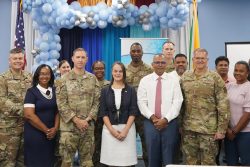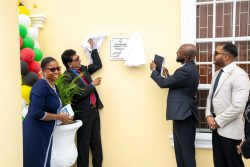Introduction
Over the past six decades, excluding the 1978 Referendum, there have been 13 general elections in Guyana. Only one woman, Mrs Janet Jagan participated in the first in November 1947. Since then women’s participation increased slowly over the years and by the last general elections in August 2006, more than one third of the candidates put up by several of the six political parties contesting the elections were women. However, for Guyanese women, as for women worldwide, participation in general elections has never been an end in itself but a significant first step in their wider quest for greater access to decision making and leadership positions. The outcome of general elections in which they have participated both as voters and candidates, is seen as the basis for their participation in Parliament and as the “main path to positions as elected head of state or government as well as nominations to cabinet ministers or other top political functions,” (this has not always been the case in Guyana) where important decisions that impact on their lives are made. The principle of equality and political participation was enshrined in Article 1 of the 1945 United Nations Charter. Additionally, several other international conventions dealing with the status of women, especially in the area of power and decision making have been signed and ratified by the Government of Guyana. It is within this context that women’s participation in the last six decades of general elections will be examined.
General Elections from 1947 through 1968
The first session of the United Nations Commission on the Status of Women was held in 1947, the same year as the first elections under review. Its terms of reference emphasized that its function was to prepare recommendations and reports for the Economic and Social Council on primarily women’s rights in political, economic, social and educational fields. The then 27 year old Mrs. Janet Jagan the lone woman who, as an Independent, contested British Guiana’s November 24, 1947 general elections, made possible through a grudging concession by a 1945 ordinance saw far beyond the very limited role envisaged for women by the dominant patriarchal, coloured middle class decision makers. The year before, she together with her husband, Dr. Cheddi Jagan, H. J. M. Hubbard and Ashton Chase had formed the Political Affairs Committee with a view to the creation of “a theoretical organ and political platform” and “to help organise the people to fight for their rights.” That same year also, Mrs. Jagan, Winifred Gaskin and several other politically aware middle class women established the Women’s Political and Economic Organization (WPEO) with a mandate “to ensure the political organization and education of the women of British Guiana in order to promote their economic welfare and their political and social emancipation and betterment.” She failed in her bid to gain a seat in the Legislative Council largely because of, as correctly stated by her husband in The West on Trial the extremely limited franchise. But her participation in that election was an ominous foreshadow of United States interference in British Guiana’s affairs. Though the Cold War had hardly begun and McCarthyism was still to come, she was stripped of her American citizenship. It took two decades and a Supreme Court decision for it to be restored.
The year prior to the landmark 1953 general elections, the United Nations passed the Convention on the Political Rights of Women. It, together with the 1966 International Covenant on Civil and Political Rights urged countries to put women’s political rights on equal footing with men’s and to give women equal opportunity to serve in public life. 1952 was also the year when one of the main platforms of the WPEO, universal adult suffrage was granted. The April 24, 1953 general elections saw a landslide victory for the newly-formed mass-based multiracial People’s Progressive Party (PPP) which gained 18 (66%) of the 24 seats. Six women, Janet Jagan, Jane Phillips-Gay and Jessica Burnham of the PPP, Gertrude Collins of the National Democratic Party and Independents Esther Day and Hermina Lepse-Brown, contested the elections. However, none of the three PPP Parliamentarians was granted ministerial positions though Janet Jagan was appointed Deputy Speaker. This was the beginning of a trend that was obvious locally and worldwide. Women, in those early years, were never automatic choices for ministerial positions. This was undoubtedly influenced by male perception of a woman’s rightful place in the scheme of things.
The August 12, 1957 general elections were contested under difficult circumstances. In 1955, the PPP had split into Jaganite and Burnhamite factions in the middle of the period of the Interim government which had been put in place after the suspension of the Waddington Constitution, 133 days after the successful PPP had taken office. Five (9%) of the 55 candidates were women – two from the Jaganite faction of the PPP and three from the Burnhamite faction. Only Janet Jagan won her seat. She was rewarded with the Portfolio of Minister of Labour, Health and Housing in the government. This was the first of several ministerial positions she was to hold over the next half century. Ironically, the next election in 1961 which witnessed the largest turnout of women voters since the 1953 general elections also saw the defeat of the three women who contested the elections. This too was an observable trend in respect of women’s political participation and one of the constraints faced by women who aspire to political office. Women, perhaps out of traditional socialization often prefer to vote for men even where there is a woman as candidate. Worldwide this trend is slowly changing, but it is difficult to gauge in Guyana’s case since we vote for a list rather than individual candidates. As a result of this election, contested by three political parties – the PPP, the People’s National Congress (PNC) the name taken by the Burnhamite faction of the PPP in 1959 and the United Force (UF) created by a Portuguese businessman, Peter D’Aguiar in 1960, 2(15.3%) of 13 seats in the newly created Senate were held by women, Mrs. Christine Allicock of the PPP and Ann Jardine of the UF. Mrs. Janet Jagan was only appointed Minister of Home Affairs after the male incumbent died suddenly.
The December 7, 1964 general elections, the last before political independence in 1966 was held under the imposed system of Proportional Representation with 53 seats up for grabs. Seven political parties contested the elections. 15 (7.5%) of the 200 candidates who contested the elections were women – 2(5.7%) of the 35 candidates put up by the PPP were women, 6 (11.3%) of the PNC’s 53, 5(9.5%) of the UF’s 53, 1 (2.7%) of the Justice Party’s 36, none of the Guyana United Muslim Party (GUMP), 1(16.6%) of the National Labour Front’s 6 and none of the Peace, Equality and Prosperity Party’s 3 candidates were women. Both of the PPP’s candidates lost. As a result of the elections a PNC/UF coalition came to power and one woman, Mrs. Winifred Gaskin was made Minister of Education. The PNC were to remain in office for the next 28 years. In all of the next four general elections which they won (many would say rigged) women were appointed to cabinet positions but in very small numbers and none of them held positions of significant decision making or power. In fact their ministerial portfolios were little more than the logical extensions of women’s caring and nurturing roles – health, education, culture, consumer affairs, mobilization or they were Ministers within the ministry which meant that decisions were made by the male ministers.
In the December 16, 1968 general elections all four political parties – the PPP, PNC, UF and GUMP contested all the 53 seats. Six (11.3%) of the candidates of the PNC were women, 5 (9.4%) of both the PPP and UF were women and 11 (an impressive 20.4%) of GUMP’s candidate were women. This party’s result at the polls serves as a good illustration of the fact that wom
en do not necessarily vote for women, although in Guyana’s case there are additional negative contributory factors. GUMP actually received 899 (a minuscule 0.3%) of the 275,849 valid local votes cast. In fact more ballots were rejected than it received. As a result of the 1968 elections, the PNC gained enough votes 55.8% and 30 seats to form the government on its own. Despite its sizeable majority, only one woman, Mrs. Shirley Field Ridley was appointed a minister and she replaced Mrs. Winifred Gaskin who the year before had been appointed Guyana’s first High Commissioner to the Commonwealth Caribbean. Only two other women from the PNC, Margaret Ackman and Patricia Limerick became members of Parliament. The other two opposition parties had an even smaller number of women parliamentarians, Eleanor DaSilva (UF) and Philomena Sahoye-Shury, (PPP)
In the next article, the discussions on women’s participation in general elections will be concluded.








